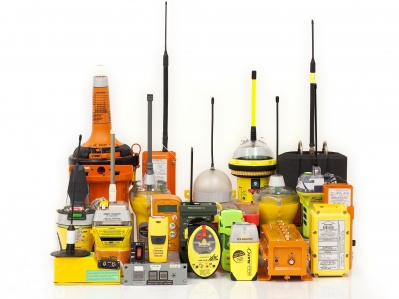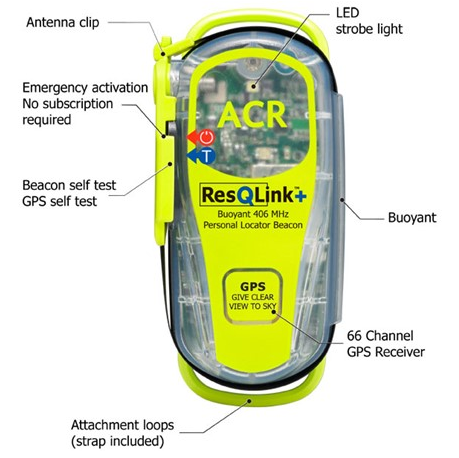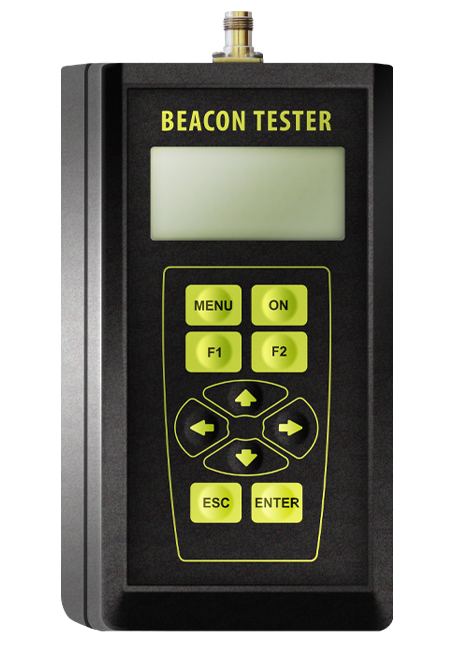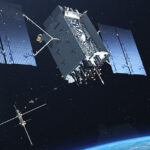A sophisticated satellite-based system allows pinpointing a person’s location in a dangerous, isolated situation on land or sea. It thus hopefully speeds their subsequent rescue in many cases.
Over one million emergency beacons are in use worldwide, all operating at 406 MHz (with some exceptions, called out below). Cospas-Sarsat does not manufacture or sell beacons. Instead, it works closely with companies that design or manufacture them and defines rigorous standards for performance, ruggedness, test, and more. The Cospas-Sarsat system uses three types of emergency beacons depending on whether they are carried on aircraft, on maritime vessels, or by individuals:
- The beacon designed for aircraft is called an Emergency Locator Transmitter (ELT) and is manually activated or automatically in the event of a crash.
- The one intended for use aboard a marine vessel is called an Emergency Position-Indicating Radio Beacon (EPIRB); again, it can be manually activated but also automatically if it contacts water.
- The beacon to be carried by an individual is known as a Personal Locator Beacon (PLB) and is manually activated.
The beacons come in various form factors, tailored to the operating circumstances (Figure 1).

Figure 2 shows one Personal Locator Beacon which rents for just $3 per day – well worth it, without a doubt. The unit is just 4.59 x 1.9 x 1.6 inches and weighs 5.4 oz. The buoyant/floating PLB includes a 66-channel GPS, flexible blade antenna, and continuous strobe. It incorporates three levels of integrated signal technology: GPS positioning, a powerful 406-MHz signal, 121.5 MHz homing capability, and a built-in strobe light to provide visibility during night rescues.

In 2021, there were 330 rescues in the U.S. network region. Of these, 195 were at sea via EPIRBs, 29 were aviation rescues (ELTs), and 106 were terrestrial rescues (PLBs). Worldwide industry and government regulations covering transport now require the appropriate beacon on all international flights, commercial fishing vessels, and all passenger ships in international waters, as well as many other situations.
The beacon signal uses binary phase-shift keying (BPSK), with two allowed bit-string lengths: 112 bits with 87 bits of message information and 144 bits with 119 bits of message information) Several message protocols are defined for the message to accommodate the three different kinds of beacons (ELTs, EPIRBs, and PLBs), different vessel/aircraft identifiers, and different national requirements. Each narrowband transmission takes approximately one-half second and occupies about 3 kHz of bandwidth in a given channel assignment in the assigned 406.0 to 406.1 MHz band.
Note that the beacon must be a model that transmits at 406 MHz to receive its alerts by satellite and the full system. Older-model ELTs only transmit a legacy analog signal on 121.5 MHz or 243 MHz, but the Cospas-Sarsat does not monitor those frequencies. The signal from those beacons can be received only by nearby aircraft or rescue personnel. Second-generation 406-MHz beacons were introduced in 1997 to provide the 406-MHz message along with encoded position data, if accessible by the beacon. This position data comes from a global navigation satellite system (GNSS) such as GPS, and it can be provided from a GNSS receiver in the beacon or by an external GNSS receiver linked to the beacon.
Beacon Test
It’s critical to test the beacon, and the beacon design specifications mandate a detailed self-test mode. At the same time, the test cannot initiate a false alarm for obvious reasons. A comprehensive set of self-test exercises verifies all the internal circuitry, indicator LEDs, audible alarms, and more in test mode.
Since the Cospas-Sarsat system is an always-on operational system, it is not designed for live testing with an actual emergency signal. Therefore, the final beacon test involves sending out a modified code stream that the system knows is just for test and can be ignored.
Beyond the do-it-yourself self-test and dummy message modes, vendors offer specialized test instrumentation that fully exercises a beacon and measures many critical internal and external performance parameters such as battery condition, leakage current, RF signal output strength, and more (Figure 3).

Any time a beacon is activated other than in self-test mode with its modified code signal, it sends out what is interpreted as a distress signal. This is why live testing of a beacon with a genuine code is not authorized without special high-level approvals – “notification” alone is not enough. However, suppose an actual emergency-code signal is sent out by accident (it does happen). In that case, it’s critical that the user immediately notifies the appropriate authorities to let them know, as a false alarm has major consequences and costs in personnel, opportunity, use of resources, risk, and more.
The next part of this series will cover the space segments and the three types of Cospas-Sarsat satellites.
EE World References
- GPS is a ubiquitous and problematic technology
- Basics of GPS receivers
- GPS, Part 1: Basic principles
- GPS, Part 2: Implementation
- Iridium global satcom system: Brilliant design, terrible business, last-minute reprieve, Part 1
- The Iridium global satcom system, Part 2: The implementation
- The Iridium global satcom system, Part 3: Very nearly crash and burn
- The Iridium global satcom system, Part 4: Lessons learned
- The Iridium global satcom system, Part 5: Advances and competition
External References
There is a lot of good information at the site of the international Cospas-Sarsat Program, especially these pages:
- Cospas-Sarsat, “Detailed Cospas-Sarsat System Description”
- Cospas-Sarsat, “What is a Cospas-Sarsat Beacon?”
- Cospas-Sarsat, “Beacon FAQ”
- Cospas-Sarsat, “What Happens When I Activate My Beacon?”
- Cospas-Sarsat, “How Do I Select and Purchase a Cospas-Sarsat Beacon?”
Other references
- NASA, “Search and Rescue (SAR) Overview”
- NASA, “NASA Develops Second-Generation Search and Rescue Beacon Technology”
- NASA, “LunaSAR: An Astronaut’s Lunar Lifeline”
- NASA, “LunaNet: Empowering Artemis with Communications and Navigation Interoperability”
- SciTech Daily, “NASA Emergency Beacons Saved 330 Lives in 2021”
- Earl Swift, Harper Collins, “Across the Airless Wilds: The Lunar Rover and the Triumph of the Final Moon Landings”
- GIFER, “Polar orbits” (Dynamic GIF)
Test-related References
- Department of Commerce/National Oceanic and Atmospheric Administration (NOAA), “Emergency Beacon Testing”
- GMD Testers, “Beacon Tester”
- WS Technologies Inc., “Beacon Testers”





Leave a Reply